National Economics University: AI in Talent Acquisition Essay
VerifiedAdded on 2023/01/17
|25
|6809
|75
Essay
AI Summary
This essay from National Economics University examines the multifaceted role of Artificial Intelligence (AI) in talent acquisition. It defines talent acquisition and AI, then explores how AI supports business functions through automation, cognitive insights, and engagement. The essay details the benefits of AI in talent acquisition, including broadening applicant pools, reaching passive candidates, enhancing e-recruiting and e-selection, simplifying job analysis, facilitating online testing, enabling remote interviewing, and supporting effective selection decisions. It also addresses potential risks associated with AI implementation. The essay highlights the strategic importance of AI in modern human resource management and its impact on improving recruitment and selection outcomes, particularly in the context of a competitive job market. It emphasizes the advantages of AI tools and their role in improving the efficiency of talent acquisition processes.
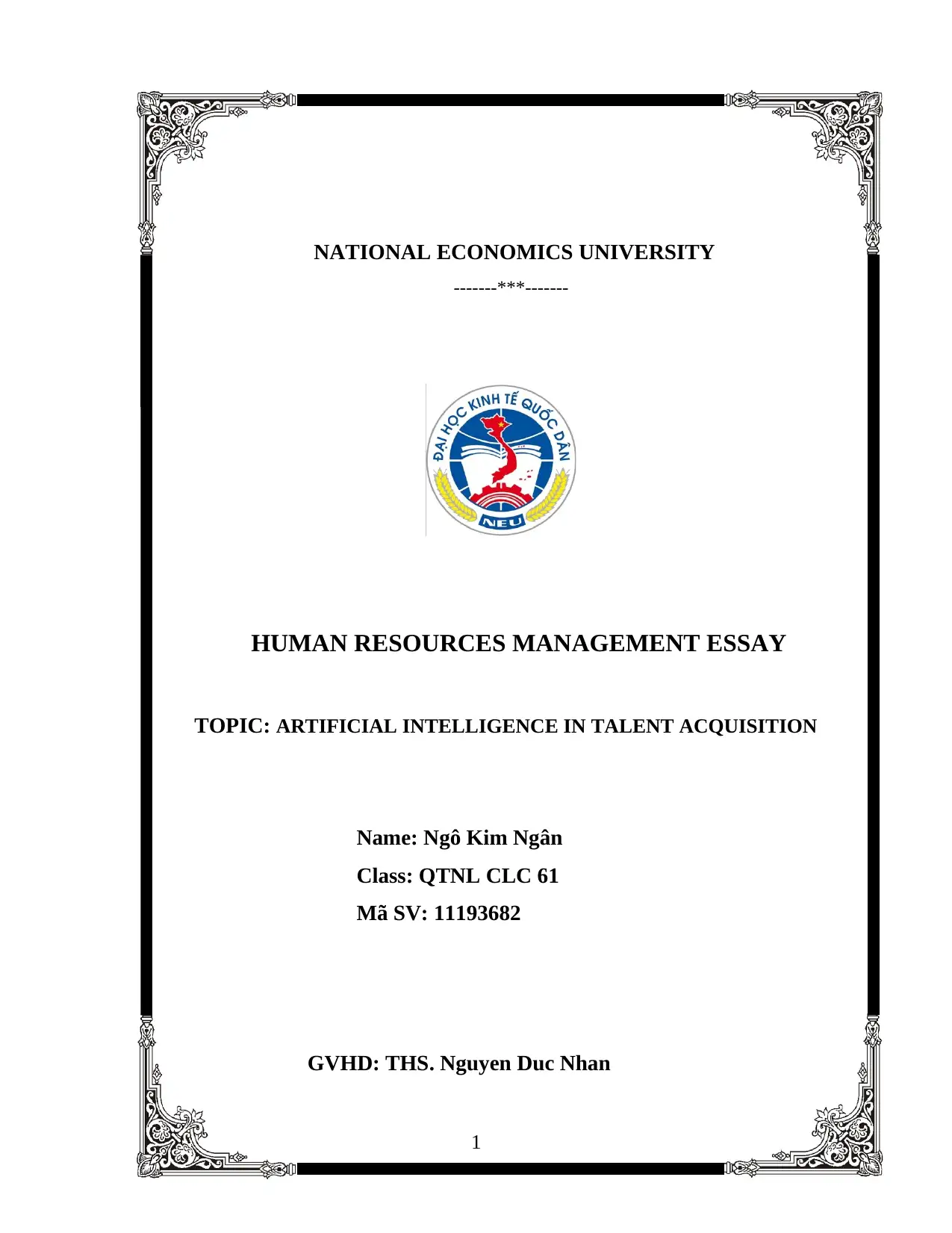
NATIONAL ECONOMICS UNIVERSITY
-------***-------
HUMAN RESOURCES MANAGEMENT ESSAY
TOPIC: ARTIFICIAL INTELLIGENCE IN TALENT ACQUISITION
Name: Ngô Kim Ngân
Class: QTNL CLC 61
Mã SV: 11193682
GVHD: THS. Nguyen Duc Nhan
1
-------***-------
HUMAN RESOURCES MANAGEMENT ESSAY
TOPIC: ARTIFICIAL INTELLIGENCE IN TALENT ACQUISITION
Name: Ngô Kim Ngân
Class: QTNL CLC 61
Mã SV: 11193682
GVHD: THS. Nguyen Duc Nhan
1
Paraphrase This Document
Need a fresh take? Get an instant paraphrase of this document with our AI Paraphraser

HA NOI, 2022
2
2
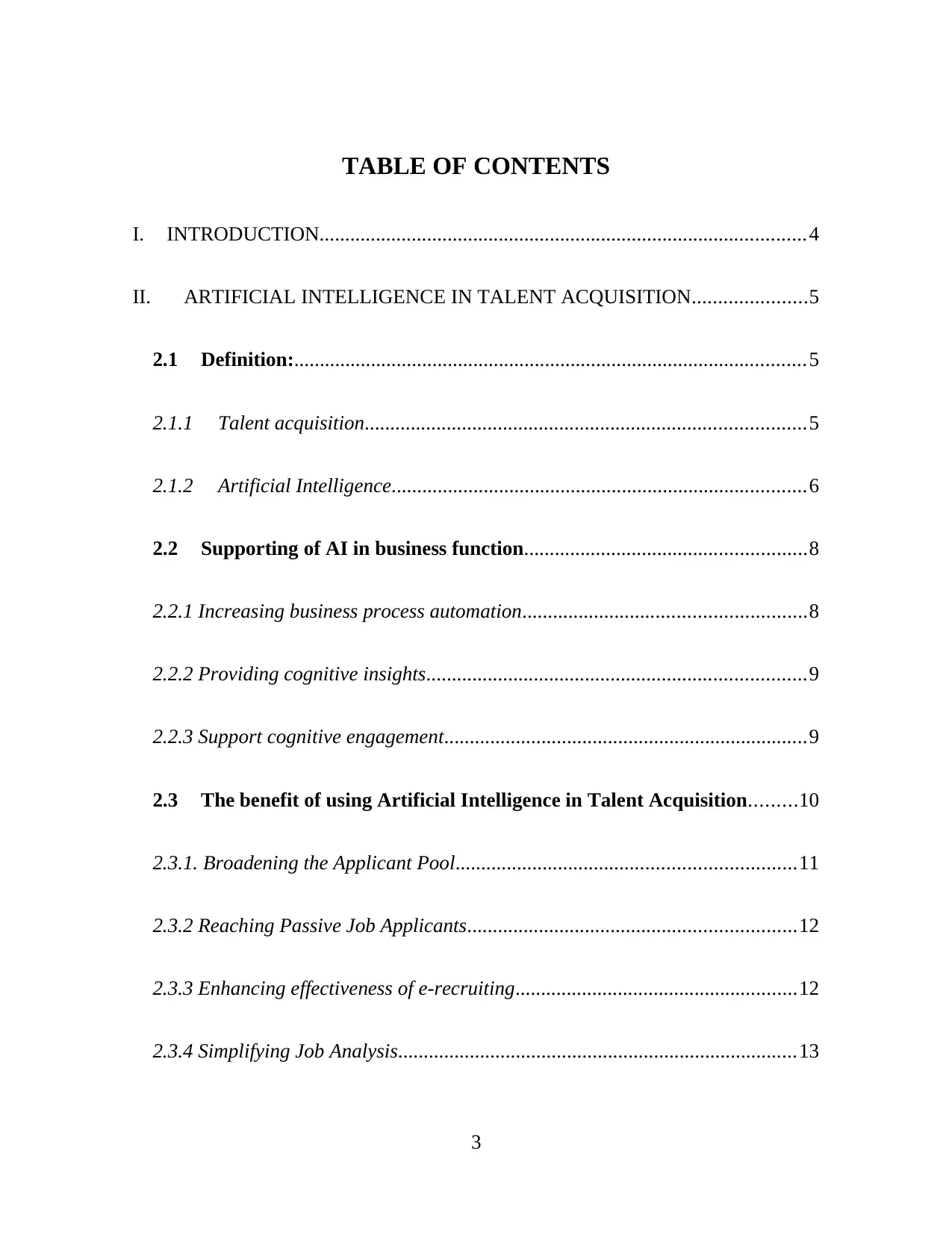
TABLE OF CONTENTS
I. INTRODUCTION...............................................................................................4
II. ARTIFICIAL INTELLIGENCE IN TALENT ACQUISITION......................5
2.1 Definition:....................................................................................................5
2.1.1 Talent acquisition......................................................................................5
2.1.2 Artificial Intelligence.................................................................................6
2.2 Supporting of AI in business function.......................................................8
2.2.1 Increasing business process automation.......................................................8
2.2.2 Providing cognitive insights..........................................................................9
2.2.3 Support cognitive engagement.......................................................................9
2.3 The benefit of using Artificial Intelligence in Talent Acquisition.........10
2.3.1. Broadening the Applicant Pool..................................................................11
2.3.2 Reaching Passive Job Applicants................................................................12
2.3.3 Enhancing effectiveness of e-recruiting.......................................................12
2.3.4 Simplifying Job Analysis..............................................................................13
3
I. INTRODUCTION...............................................................................................4
II. ARTIFICIAL INTELLIGENCE IN TALENT ACQUISITION......................5
2.1 Definition:....................................................................................................5
2.1.1 Talent acquisition......................................................................................5
2.1.2 Artificial Intelligence.................................................................................6
2.2 Supporting of AI in business function.......................................................8
2.2.1 Increasing business process automation.......................................................8
2.2.2 Providing cognitive insights..........................................................................9
2.2.3 Support cognitive engagement.......................................................................9
2.3 The benefit of using Artificial Intelligence in Talent Acquisition.........10
2.3.1. Broadening the Applicant Pool..................................................................11
2.3.2 Reaching Passive Job Applicants................................................................12
2.3.3 Enhancing effectiveness of e-recruiting.......................................................12
2.3.4 Simplifying Job Analysis..............................................................................13
3
⊘ This is a preview!⊘
Do you want full access?
Subscribe today to unlock all pages.

Trusted by 1+ million students worldwide
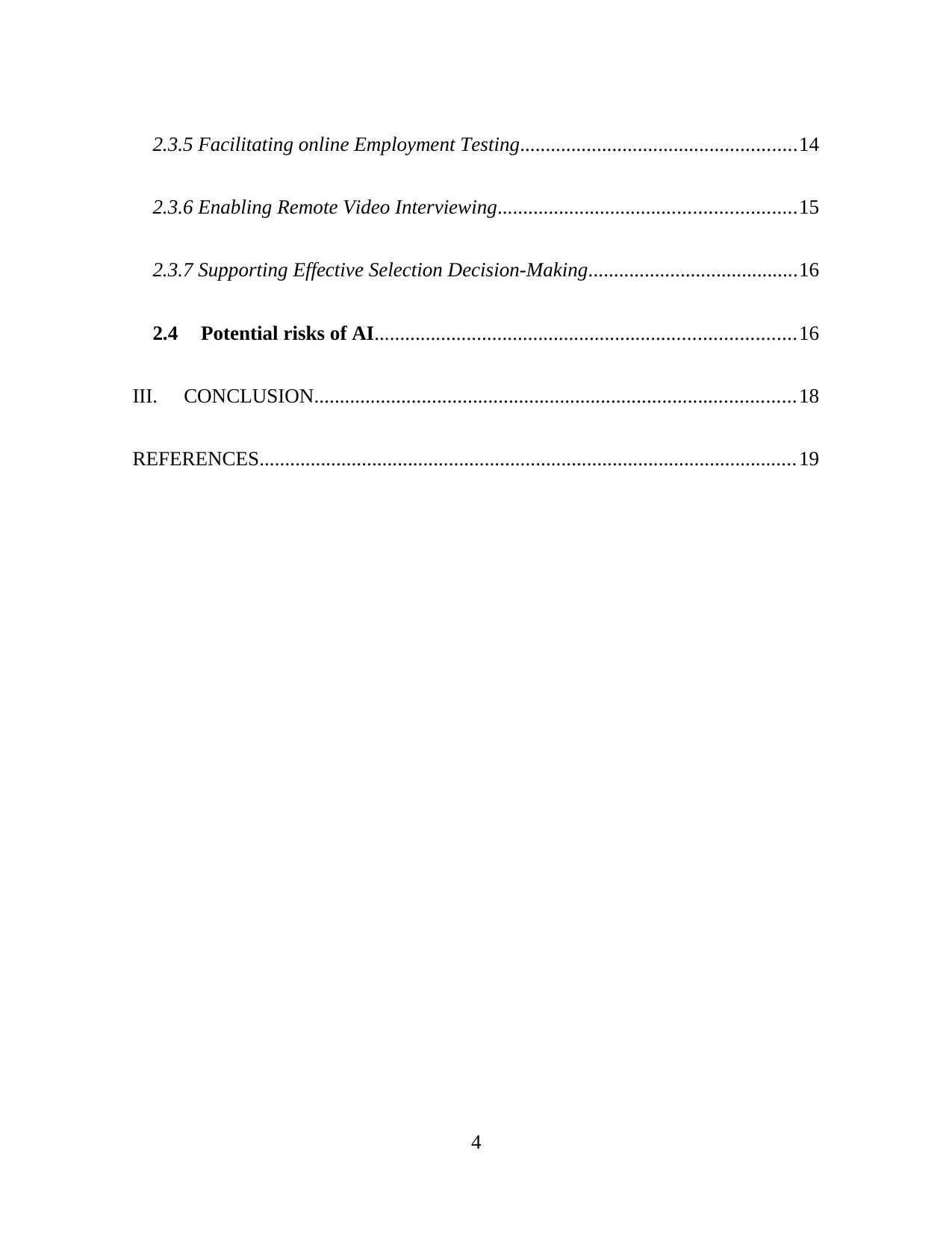
2.3.5 Facilitating online Employment Testing......................................................14
2.3.6 Enabling Remote Video Interviewing..........................................................15
2.3.7 Supporting Effective Selection Decision-Making.........................................16
2.4 Potential risks of AI..................................................................................16
III. CONCLUSION..............................................................................................18
REFERENCES.........................................................................................................19
4
2.3.6 Enabling Remote Video Interviewing..........................................................15
2.3.7 Supporting Effective Selection Decision-Making.........................................16
2.4 Potential risks of AI..................................................................................16
III. CONCLUSION..............................................................................................18
REFERENCES.........................................................................................................19
4
Paraphrase This Document
Need a fresh take? Get an instant paraphrase of this document with our AI Paraphraser
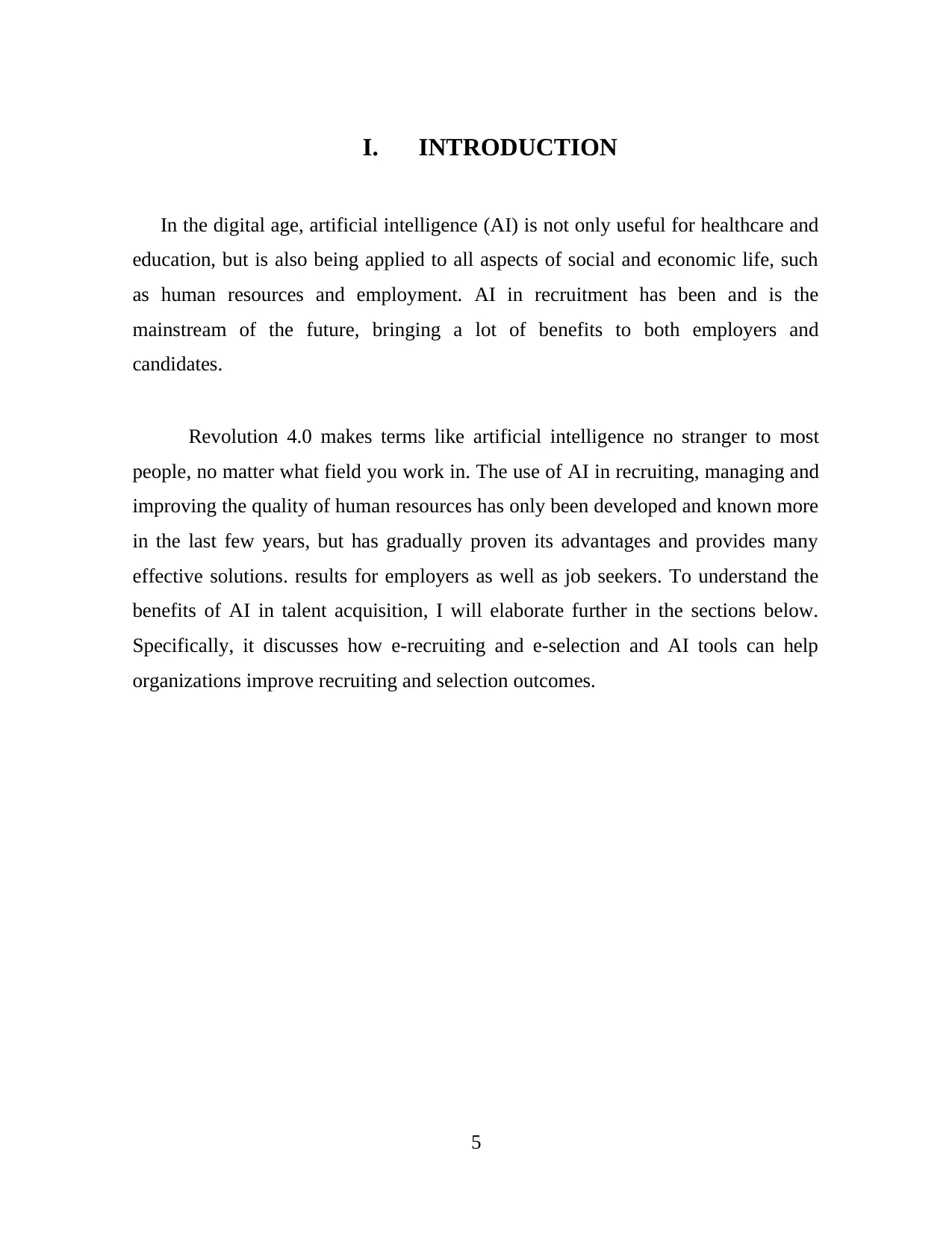
I. INTRODUCTION
In the digital age, artificial intelligence (AI) is not only useful for healthcare and
education, but is also being applied to all aspects of social and economic life, such
as human resources and employment. AI in recruitment has been and is the
mainstream of the future, bringing a lot of benefits to both employers and
candidates.
Revolution 4.0 makes terms like artificial intelligence no stranger to most
people, no matter what field you work in. The use of AI in recruiting, managing and
improving the quality of human resources has only been developed and known more
in the last few years, but has gradually proven its advantages and provides many
effective solutions. results for employers as well as job seekers. To understand the
benefits of AI in talent acquisition, I will elaborate further in the sections below.
Specifically, it discusses how e-recruiting and e-selection and AI tools can help
organizations improve recruiting and selection outcomes.
5
In the digital age, artificial intelligence (AI) is not only useful for healthcare and
education, but is also being applied to all aspects of social and economic life, such
as human resources and employment. AI in recruitment has been and is the
mainstream of the future, bringing a lot of benefits to both employers and
candidates.
Revolution 4.0 makes terms like artificial intelligence no stranger to most
people, no matter what field you work in. The use of AI in recruiting, managing and
improving the quality of human resources has only been developed and known more
in the last few years, but has gradually proven its advantages and provides many
effective solutions. results for employers as well as job seekers. To understand the
benefits of AI in talent acquisition, I will elaborate further in the sections below.
Specifically, it discusses how e-recruiting and e-selection and AI tools can help
organizations improve recruiting and selection outcomes.
5
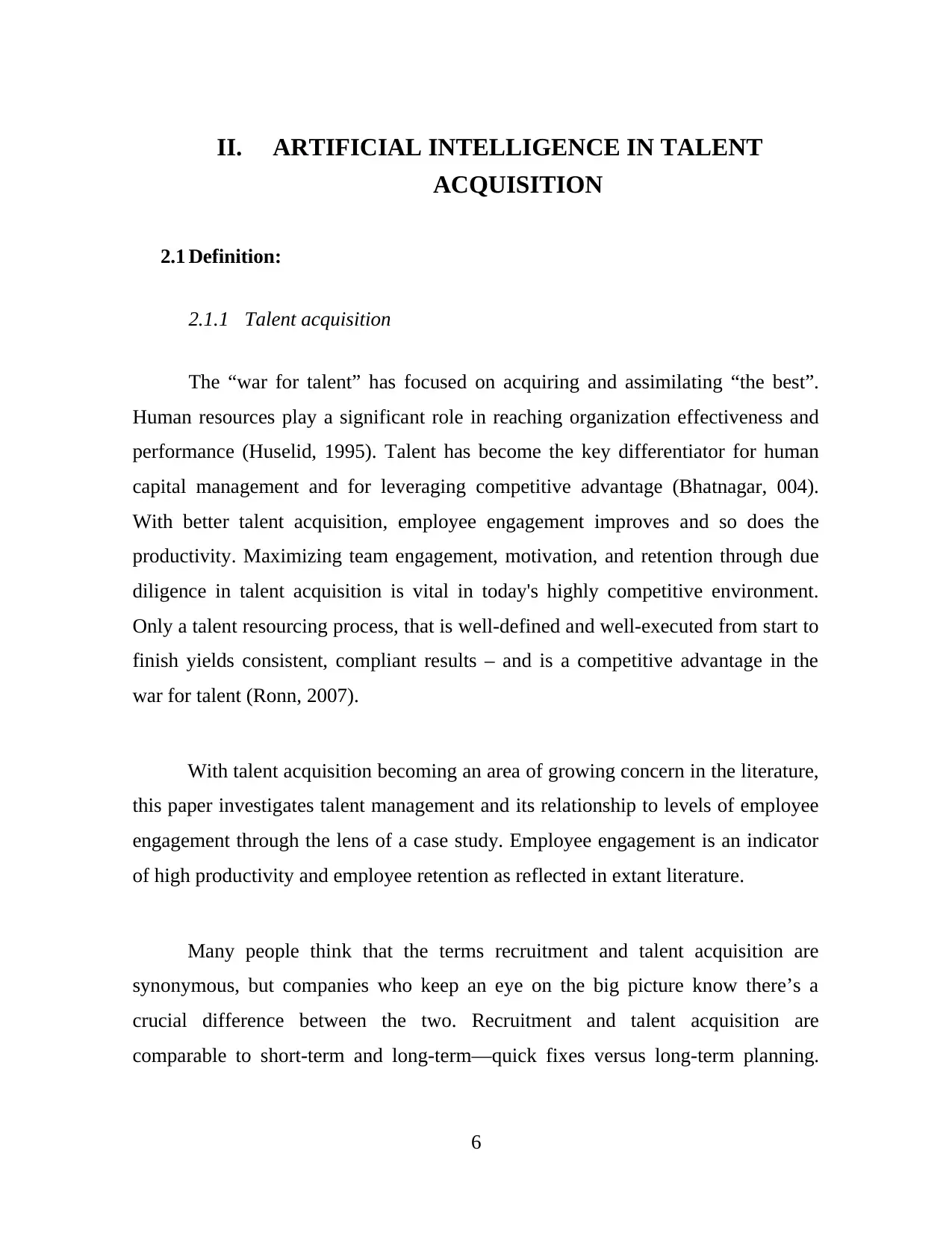
II. ARTIFICIAL INTELLIGENCE IN TALENT
ACQUISITION
2.1 Definition:
2.1.1 Talent acquisition
The “war for talent” has focused on acquiring and assimilating “the best”.
Human resources play a significant role in reaching organization effectiveness and
performance (Huselid, 1995). Talent has become the key differentiator for human
capital management and for leveraging competitive advantage (Bhatnagar, 004).
With better talent acquisition, employee engagement improves and so does the
productivity. Maximizing team engagement, motivation, and retention through due
diligence in talent acquisition is vital in today's highly competitive environment.
Only a talent resourcing process, that is well‐defined and well‐executed from start to
finish yields consistent, compliant results – and is a competitive advantage in the
war for talent (Ronn, 2007).
With talent acquisition becoming an area of growing concern in the literature,
this paper investigates talent management and its relationship to levels of employee
engagement through the lens of a case study. Employee engagement is an indicator
of high productivity and employee retention as reflected in extant literature.
Many people think that the terms recruitment and talent acquisition are
synonymous, but companies who keep an eye on the big picture know there’s a
crucial difference between the two. Recruitment and talent acquisition are
comparable to short-term and long-term—quick fixes versus long-term planning.
6
ACQUISITION
2.1 Definition:
2.1.1 Talent acquisition
The “war for talent” has focused on acquiring and assimilating “the best”.
Human resources play a significant role in reaching organization effectiveness and
performance (Huselid, 1995). Talent has become the key differentiator for human
capital management and for leveraging competitive advantage (Bhatnagar, 004).
With better talent acquisition, employee engagement improves and so does the
productivity. Maximizing team engagement, motivation, and retention through due
diligence in talent acquisition is vital in today's highly competitive environment.
Only a talent resourcing process, that is well‐defined and well‐executed from start to
finish yields consistent, compliant results – and is a competitive advantage in the
war for talent (Ronn, 2007).
With talent acquisition becoming an area of growing concern in the literature,
this paper investigates talent management and its relationship to levels of employee
engagement through the lens of a case study. Employee engagement is an indicator
of high productivity and employee retention as reflected in extant literature.
Many people think that the terms recruitment and talent acquisition are
synonymous, but companies who keep an eye on the big picture know there’s a
crucial difference between the two. Recruitment and talent acquisition are
comparable to short-term and long-term—quick fixes versus long-term planning.
6
⊘ This is a preview!⊘
Do you want full access?
Subscribe today to unlock all pages.

Trusted by 1+ million students worldwide
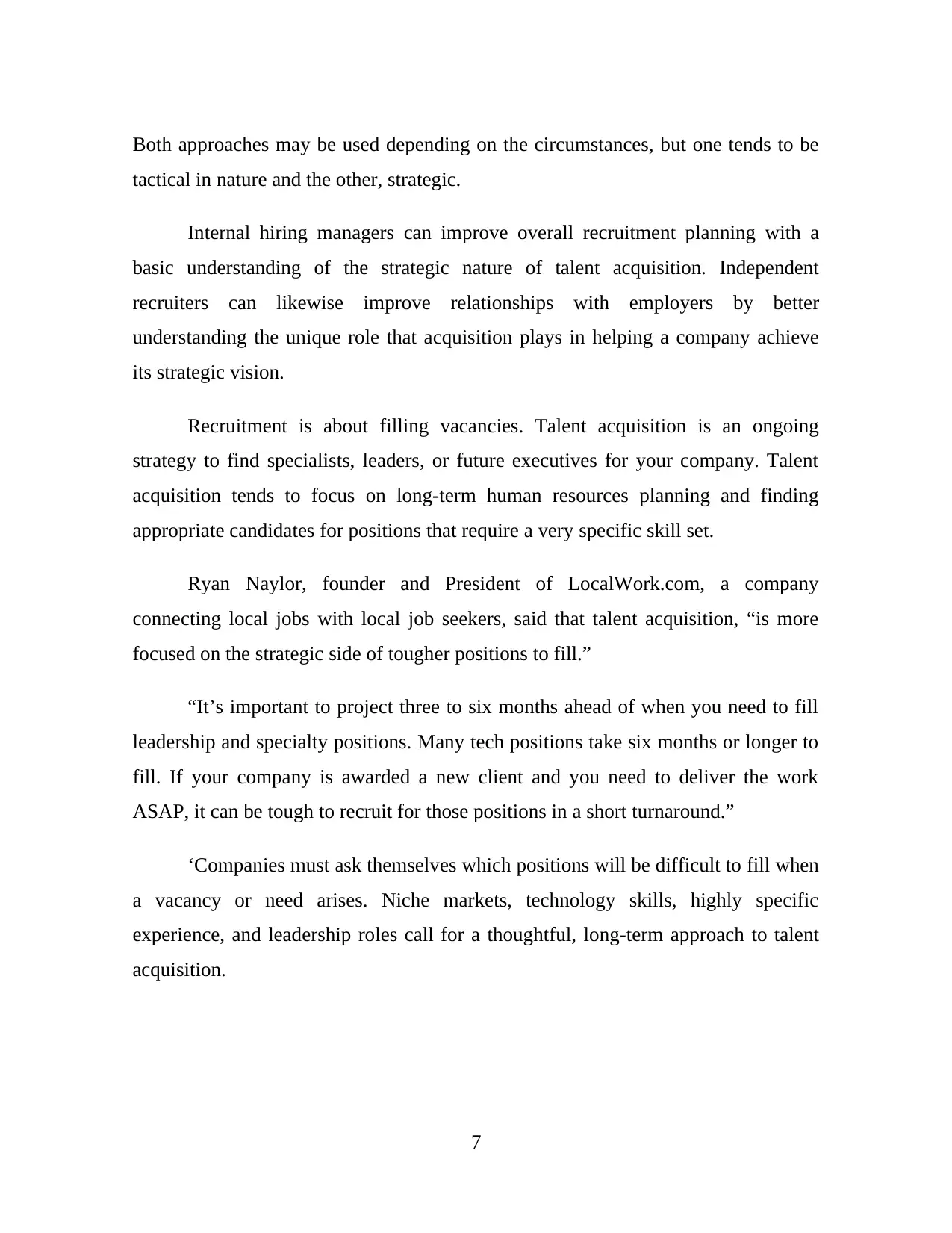
Both approaches may be used depending on the circumstances, but one tends to be
tactical in nature and the other, strategic.
Internal hiring managers can improve overall recruitment planning with a
basic understanding of the strategic nature of talent acquisition. Independent
recruiters can likewise improve relationships with employers by better
understanding the unique role that acquisition plays in helping a company achieve
its strategic vision.
Recruitment is about filling vacancies. Talent acquisition is an ongoing
strategy to find specialists, leaders, or future executives for your company. Talent
acquisition tends to focus on long-term human resources planning and finding
appropriate candidates for positions that require a very specific skill set.
Ryan Naylor, founder and President of LocalWork.com, a company
connecting local jobs with local job seekers, said that talent acquisition, “is more
focused on the strategic side of tougher positions to fill.”
“It’s important to project three to six months ahead of when you need to fill
leadership and specialty positions. Many tech positions take six months or longer to
fill. If your company is awarded a new client and you need to deliver the work
ASAP, it can be tough to recruit for those positions in a short turnaround.”
‘Companies must ask themselves which positions will be difficult to fill when
a vacancy or need arises. Niche markets, technology skills, highly specific
experience, and leadership roles call for a thoughtful, long-term approach to talent
acquisition.
7
tactical in nature and the other, strategic.
Internal hiring managers can improve overall recruitment planning with a
basic understanding of the strategic nature of talent acquisition. Independent
recruiters can likewise improve relationships with employers by better
understanding the unique role that acquisition plays in helping a company achieve
its strategic vision.
Recruitment is about filling vacancies. Talent acquisition is an ongoing
strategy to find specialists, leaders, or future executives for your company. Talent
acquisition tends to focus on long-term human resources planning and finding
appropriate candidates for positions that require a very specific skill set.
Ryan Naylor, founder and President of LocalWork.com, a company
connecting local jobs with local job seekers, said that talent acquisition, “is more
focused on the strategic side of tougher positions to fill.”
“It’s important to project three to six months ahead of when you need to fill
leadership and specialty positions. Many tech positions take six months or longer to
fill. If your company is awarded a new client and you need to deliver the work
ASAP, it can be tough to recruit for those positions in a short turnaround.”
‘Companies must ask themselves which positions will be difficult to fill when
a vacancy or need arises. Niche markets, technology skills, highly specific
experience, and leadership roles call for a thoughtful, long-term approach to talent
acquisition.
7
Paraphrase This Document
Need a fresh take? Get an instant paraphrase of this document with our AI Paraphraser
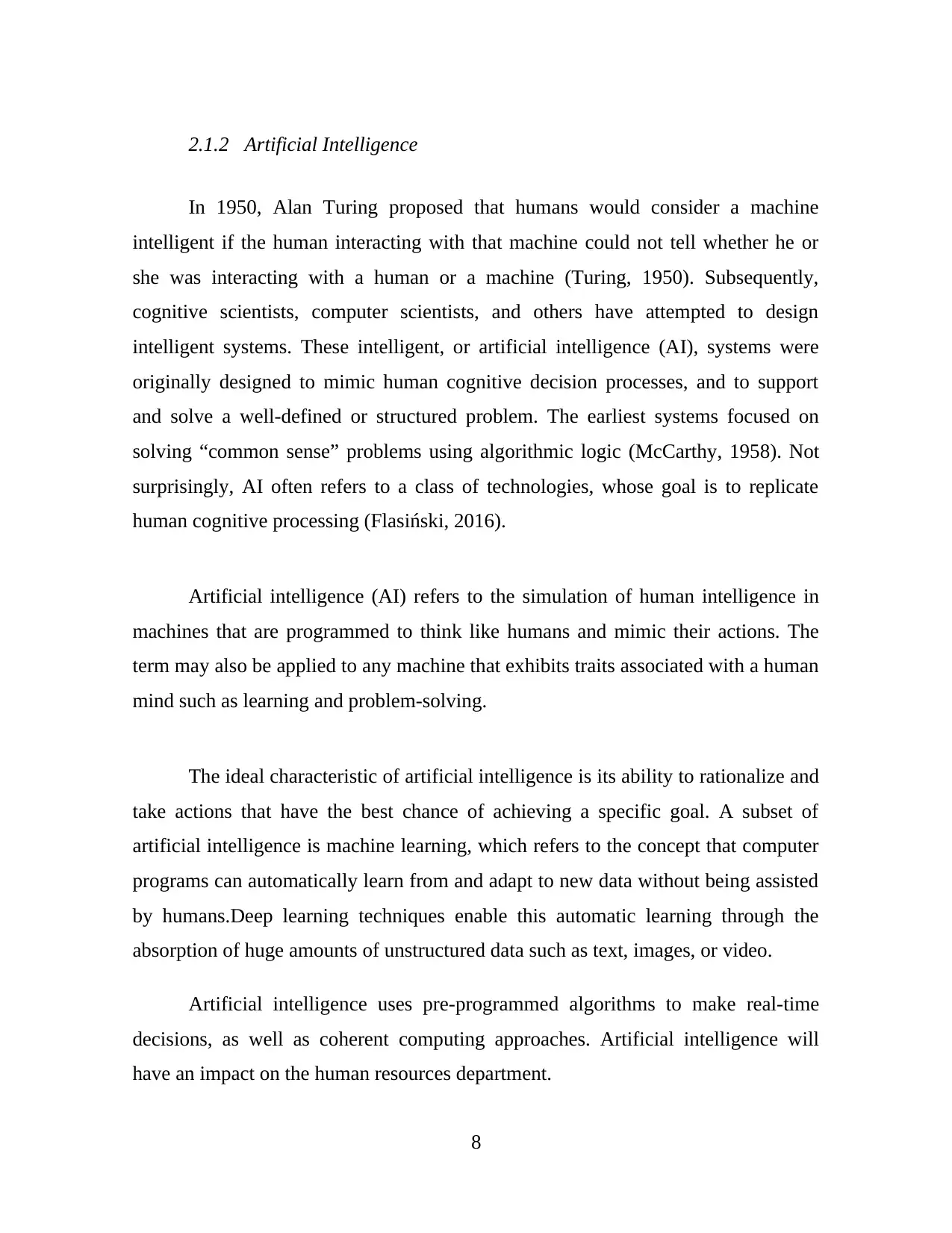
2.1.2 Artificial Intelligence
In 1950, Alan Turing proposed that humans would consider a machine
intelligent if the human interacting with that machine could not tell whether he or
she was interacting with a human or a machine (Turing, 1950). Subsequently,
cognitive scientists, computer scientists, and others have attempted to design
intelligent systems. These intelligent, or artificial intelligence (AI), systems were
originally designed to mimic human cognitive decision processes, and to support
and solve a well-defined or structured problem. The earliest systems focused on
solving “common sense” problems using algorithmic logic (McCarthy, 1958). Not
surprisingly, AI often refers to a class of technologies, whose goal is to replicate
human cognitive processing (Flasiński, 2016).
Artificial intelligence (AI) refers to the simulation of human intelligence in
machines that are programmed to think like humans and mimic their actions. The
term may also be applied to any machine that exhibits traits associated with a human
mind such as learning and problem-solving.
The ideal characteristic of artificial intelligence is its ability to rationalize and
take actions that have the best chance of achieving a specific goal. A subset of
artificial intelligence is machine learning, which refers to the concept that computer
programs can automatically learn from and adapt to new data without being assisted
by humans.Deep learning techniques enable this automatic learning through the
absorption of huge amounts of unstructured data such as text, images, or video.
Artificial intelligence uses pre-programmed algorithms to make real-time
decisions, as well as coherent computing approaches. Artificial intelligence will
have an impact on the human resources department.
8
In 1950, Alan Turing proposed that humans would consider a machine
intelligent if the human interacting with that machine could not tell whether he or
she was interacting with a human or a machine (Turing, 1950). Subsequently,
cognitive scientists, computer scientists, and others have attempted to design
intelligent systems. These intelligent, or artificial intelligence (AI), systems were
originally designed to mimic human cognitive decision processes, and to support
and solve a well-defined or structured problem. The earliest systems focused on
solving “common sense” problems using algorithmic logic (McCarthy, 1958). Not
surprisingly, AI often refers to a class of technologies, whose goal is to replicate
human cognitive processing (Flasiński, 2016).
Artificial intelligence (AI) refers to the simulation of human intelligence in
machines that are programmed to think like humans and mimic their actions. The
term may also be applied to any machine that exhibits traits associated with a human
mind such as learning and problem-solving.
The ideal characteristic of artificial intelligence is its ability to rationalize and
take actions that have the best chance of achieving a specific goal. A subset of
artificial intelligence is machine learning, which refers to the concept that computer
programs can automatically learn from and adapt to new data without being assisted
by humans.Deep learning techniques enable this automatic learning through the
absorption of huge amounts of unstructured data such as text, images, or video.
Artificial intelligence uses pre-programmed algorithms to make real-time
decisions, as well as coherent computing approaches. Artificial intelligence will
have an impact on the human resources department.
8
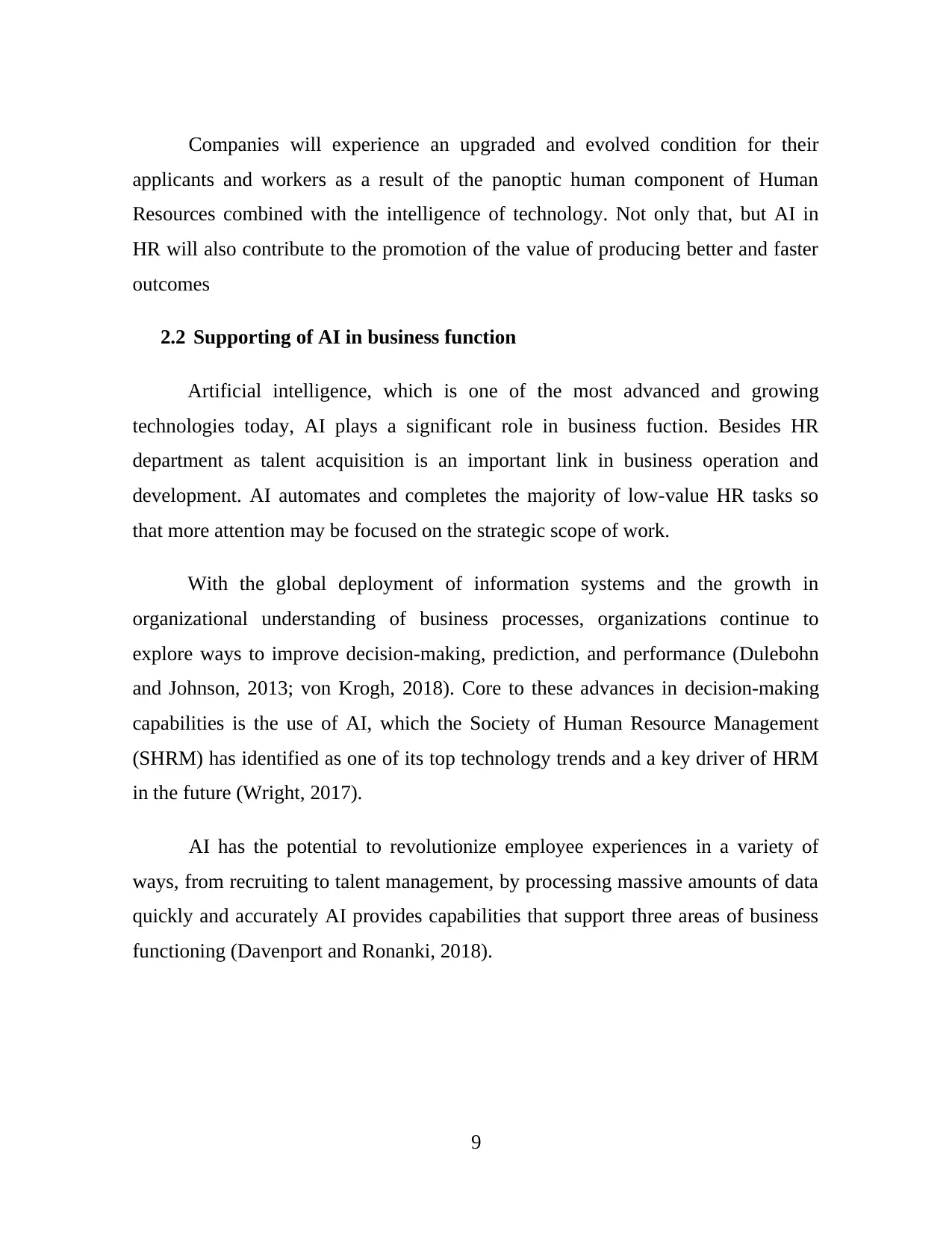
Companies will experience an upgraded and evolved condition for their
applicants and workers as a result of the panoptic human component of Human
Resources combined with the intelligence of technology. Not only that, but AI in
HR will also contribute to the promotion of the value of producing better and faster
outcomes
2.2 Supporting of AI in business function
Artificial intelligence, which is one of the most advanced and growing
technologies today, AI plays a significant role in business fuction. Besides HR
department as talent acquisition is an important link in business operation and
development. AI automates and completes the majority of low-value HR tasks so
that more attention may be focused on the strategic scope of work.
With the global deployment of information systems and the growth in
organizational understanding of business processes, organizations continue to
explore ways to improve decision-making, prediction, and performance (Dulebohn
and Johnson, 2013; von Krogh, 2018). Core to these advances in decision-making
capabilities is the use of AI, which the Society of Human Resource Management
(SHRM) has identified as one of its top technology trends and a key driver of HRM
in the future (Wright, 2017).
AI has the potential to revolutionize employee experiences in a variety of
ways, from recruiting to talent management, by processing massive amounts of data
quickly and accurately AI provides capabilities that support three areas of business
functioning (Davenport and Ronanki, 2018).
9
applicants and workers as a result of the panoptic human component of Human
Resources combined with the intelligence of technology. Not only that, but AI in
HR will also contribute to the promotion of the value of producing better and faster
outcomes
2.2 Supporting of AI in business function
Artificial intelligence, which is one of the most advanced and growing
technologies today, AI plays a significant role in business fuction. Besides HR
department as talent acquisition is an important link in business operation and
development. AI automates and completes the majority of low-value HR tasks so
that more attention may be focused on the strategic scope of work.
With the global deployment of information systems and the growth in
organizational understanding of business processes, organizations continue to
explore ways to improve decision-making, prediction, and performance (Dulebohn
and Johnson, 2013; von Krogh, 2018). Core to these advances in decision-making
capabilities is the use of AI, which the Society of Human Resource Management
(SHRM) has identified as one of its top technology trends and a key driver of HRM
in the future (Wright, 2017).
AI has the potential to revolutionize employee experiences in a variety of
ways, from recruiting to talent management, by processing massive amounts of data
quickly and accurately AI provides capabilities that support three areas of business
functioning (Davenport and Ronanki, 2018).
9
⊘ This is a preview!⊘
Do you want full access?
Subscribe today to unlock all pages.

Trusted by 1+ million students worldwide
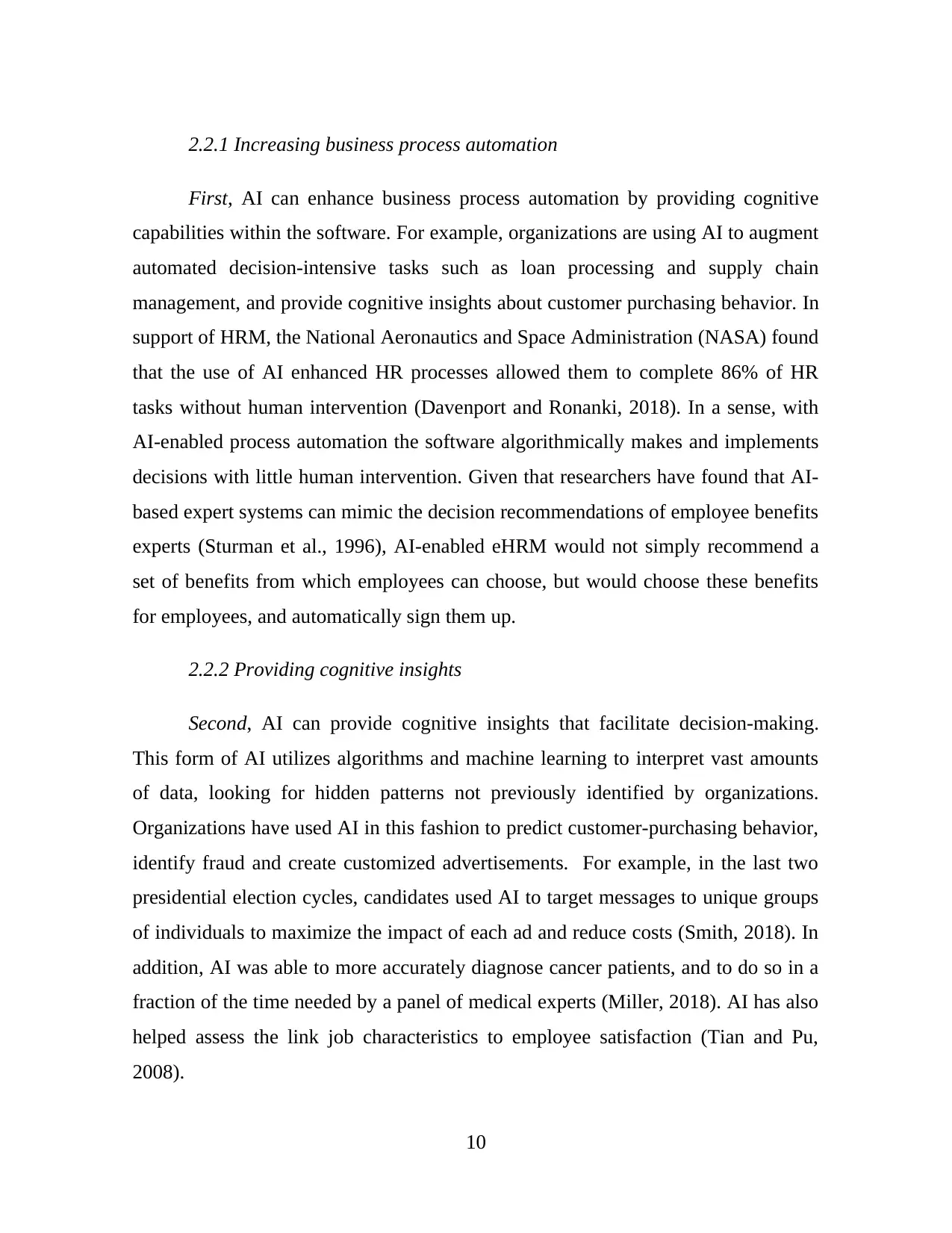
2.2.1 Increasing business process automation
First, AI can enhance business process automation by providing cognitive
capabilities within the software. For example, organizations are using AI to augment
automated decision-intensive tasks such as loan processing and supply chain
management, and provide cognitive insights about customer purchasing behavior. In
support of HRM, the National Aeronautics and Space Administration (NASA) found
that the use of AI enhanced HR processes allowed them to complete 86% of HR
tasks without human intervention (Davenport and Ronanki, 2018). In a sense, with
AI-enabled process automation the software algorithmically makes and implements
decisions with little human intervention. Given that researchers have found that AI-
based expert systems can mimic the decision recommendations of employee benefits
experts (Sturman et al., 1996), AI-enabled eHRM would not simply recommend a
set of benefits from which employees can choose, but would choose these benefits
for employees, and automatically sign them up.
2.2.2 Providing cognitive insights
Second, AI can provide cognitive insights that facilitate decision-making.
This form of AI utilizes algorithms and machine learning to interpret vast amounts
of data, looking for hidden patterns not previously identified by organizations.
Organizations have used AI in this fashion to predict customer-purchasing behavior,
identify fraud and create customized advertisements. For example, in the last two
presidential election cycles, candidates used AI to target messages to unique groups
of individuals to maximize the impact of each ad and reduce costs (Smith, 2018). In
addition, AI was able to more accurately diagnose cancer patients, and to do so in a
fraction of the time needed by a panel of medical experts (Miller, 2018). AI has also
helped assess the link job characteristics to employee satisfaction (Tian and Pu,
2008).
10
First, AI can enhance business process automation by providing cognitive
capabilities within the software. For example, organizations are using AI to augment
automated decision-intensive tasks such as loan processing and supply chain
management, and provide cognitive insights about customer purchasing behavior. In
support of HRM, the National Aeronautics and Space Administration (NASA) found
that the use of AI enhanced HR processes allowed them to complete 86% of HR
tasks without human intervention (Davenport and Ronanki, 2018). In a sense, with
AI-enabled process automation the software algorithmically makes and implements
decisions with little human intervention. Given that researchers have found that AI-
based expert systems can mimic the decision recommendations of employee benefits
experts (Sturman et al., 1996), AI-enabled eHRM would not simply recommend a
set of benefits from which employees can choose, but would choose these benefits
for employees, and automatically sign them up.
2.2.2 Providing cognitive insights
Second, AI can provide cognitive insights that facilitate decision-making.
This form of AI utilizes algorithms and machine learning to interpret vast amounts
of data, looking for hidden patterns not previously identified by organizations.
Organizations have used AI in this fashion to predict customer-purchasing behavior,
identify fraud and create customized advertisements. For example, in the last two
presidential election cycles, candidates used AI to target messages to unique groups
of individuals to maximize the impact of each ad and reduce costs (Smith, 2018). In
addition, AI was able to more accurately diagnose cancer patients, and to do so in a
fraction of the time needed by a panel of medical experts (Miller, 2018). AI has also
helped assess the link job characteristics to employee satisfaction (Tian and Pu,
2008).
10
Paraphrase This Document
Need a fresh take? Get an instant paraphrase of this document with our AI Paraphraser
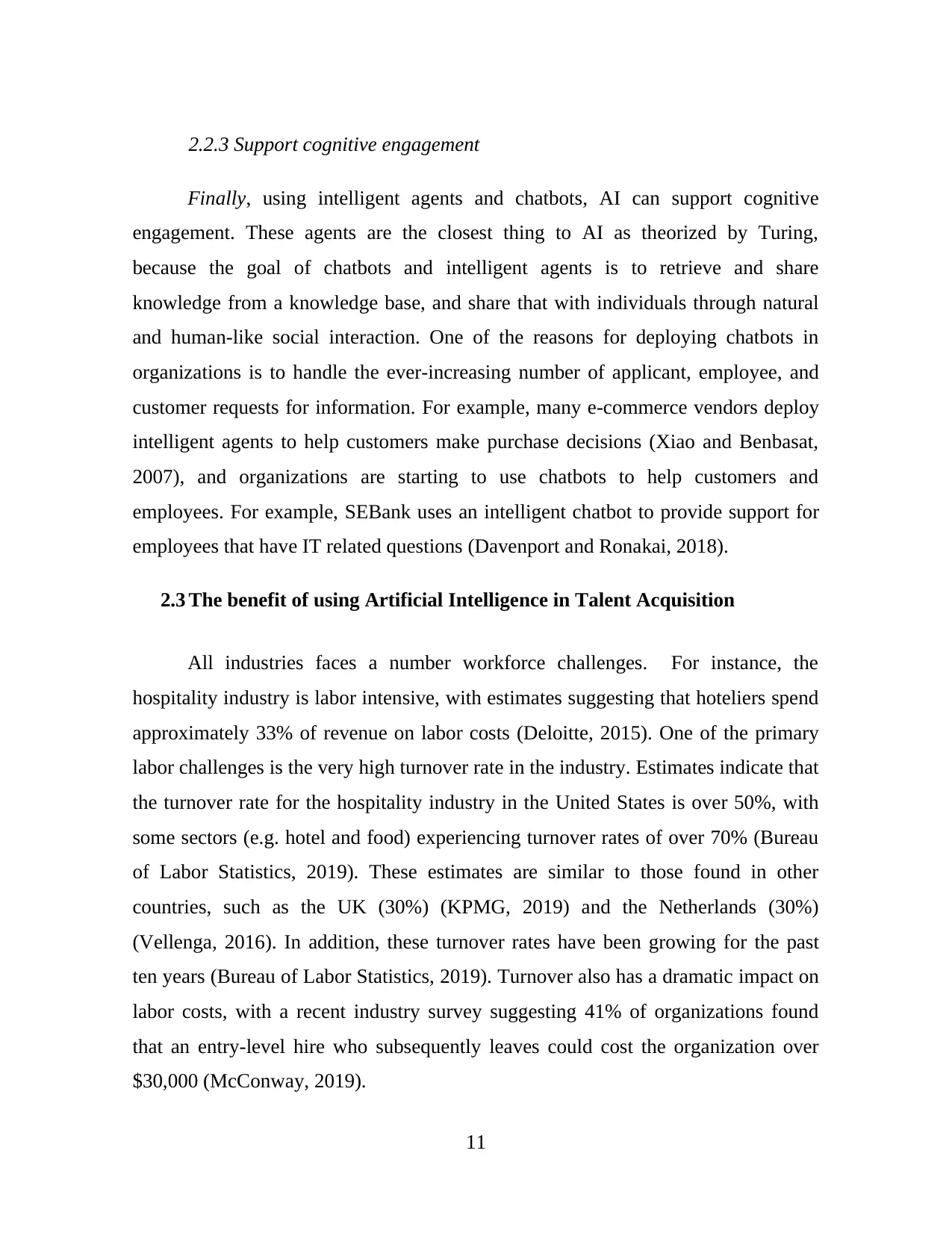
2.2.3 Support cognitive engagement
Finally, using intelligent agents and chatbots, AI can support cognitive
engagement. These agents are the closest thing to AI as theorized by Turing,
because the goal of chatbots and intelligent agents is to retrieve and share
knowledge from a knowledge base, and share that with individuals through natural
and human-like social interaction. One of the reasons for deploying chatbots in
organizations is to handle the ever-increasing number of applicant, employee, and
customer requests for information. For example, many e-commerce vendors deploy
intelligent agents to help customers make purchase decisions (Xiao and Benbasat,
2007), and organizations are starting to use chatbots to help customers and
employees. For example, SEBank uses an intelligent chatbot to provide support for
employees that have IT related questions (Davenport and Ronakai, 2018).
2.3 The benefit of using Artificial Intelligence in Talent Acquisition
All industries faces a number workforce challenges. For instance, the
hospitality industry is labor intensive, with estimates suggesting that hoteliers spend
approximately 33% of revenue on labor costs (Deloitte, 2015). One of the primary
labor challenges is the very high turnover rate in the industry. Estimates indicate that
the turnover rate for the hospitality industry in the United States is over 50%, with
some sectors (e.g. hotel and food) experiencing turnover rates of over 70% (Bureau
of Labor Statistics, 2019). These estimates are similar to those found in other
countries, such as the UK (30%) (KPMG, 2019) and the Netherlands (30%)
(Vellenga, 2016). In addition, these turnover rates have been growing for the past
ten years (Bureau of Labor Statistics, 2019). Turnover also has a dramatic impact on
labor costs, with a recent industry survey suggesting 41% of organizations found
that an entry-level hire who subsequently leaves could cost the organization over
$30,000 (McConway, 2019).
11
Finally, using intelligent agents and chatbots, AI can support cognitive
engagement. These agents are the closest thing to AI as theorized by Turing,
because the goal of chatbots and intelligent agents is to retrieve and share
knowledge from a knowledge base, and share that with individuals through natural
and human-like social interaction. One of the reasons for deploying chatbots in
organizations is to handle the ever-increasing number of applicant, employee, and
customer requests for information. For example, many e-commerce vendors deploy
intelligent agents to help customers make purchase decisions (Xiao and Benbasat,
2007), and organizations are starting to use chatbots to help customers and
employees. For example, SEBank uses an intelligent chatbot to provide support for
employees that have IT related questions (Davenport and Ronakai, 2018).
2.3 The benefit of using Artificial Intelligence in Talent Acquisition
All industries faces a number workforce challenges. For instance, the
hospitality industry is labor intensive, with estimates suggesting that hoteliers spend
approximately 33% of revenue on labor costs (Deloitte, 2015). One of the primary
labor challenges is the very high turnover rate in the industry. Estimates indicate that
the turnover rate for the hospitality industry in the United States is over 50%, with
some sectors (e.g. hotel and food) experiencing turnover rates of over 70% (Bureau
of Labor Statistics, 2019). These estimates are similar to those found in other
countries, such as the UK (30%) (KPMG, 2019) and the Netherlands (30%)
(Vellenga, 2016). In addition, these turnover rates have been growing for the past
ten years (Bureau of Labor Statistics, 2019). Turnover also has a dramatic impact on
labor costs, with a recent industry survey suggesting 41% of organizations found
that an entry-level hire who subsequently leaves could cost the organization over
$30,000 (McConway, 2019).
11
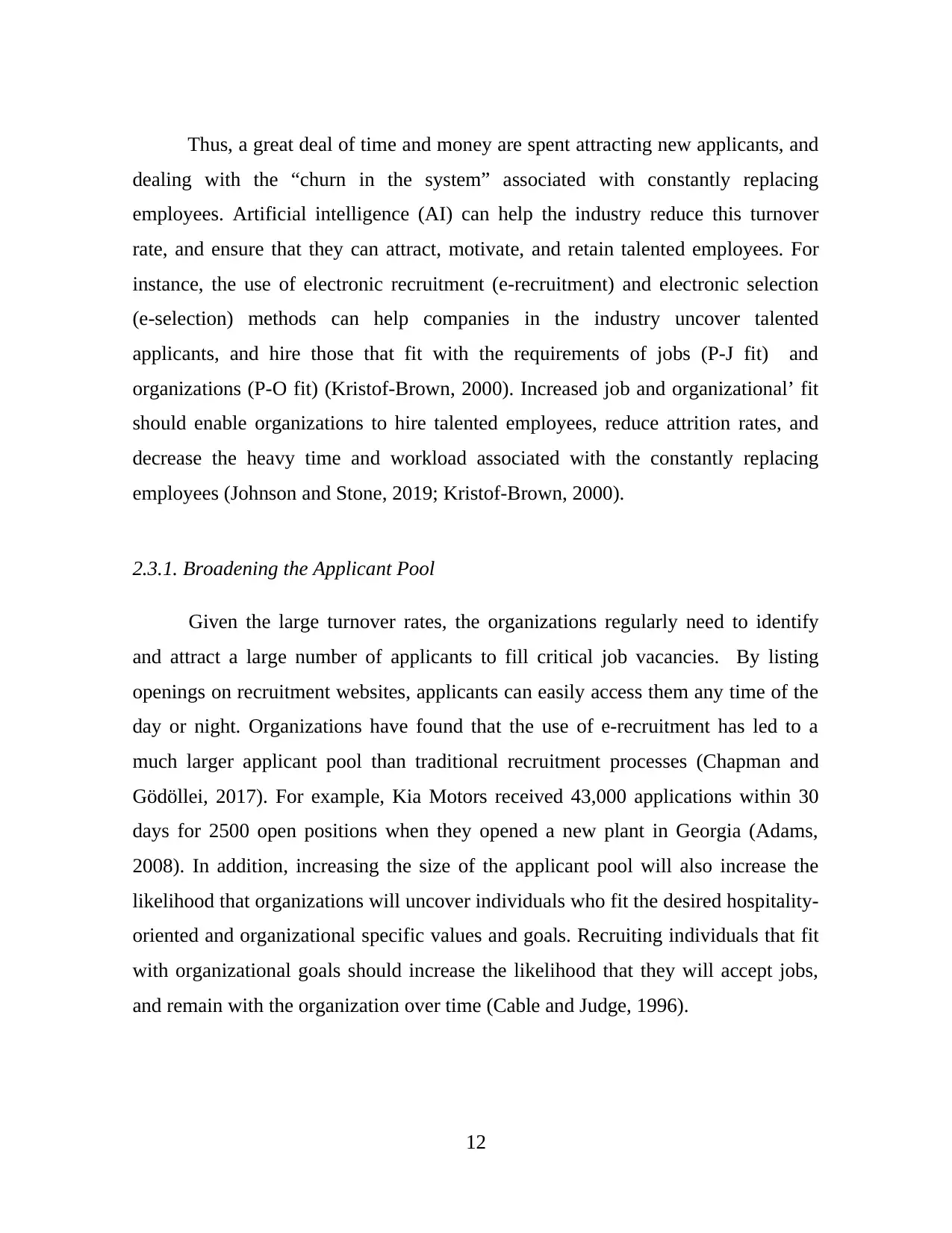
Thus, a great deal of time and money are spent attracting new applicants, and
dealing with the “churn in the system” associated with constantly replacing
employees. Artificial intelligence (AI) can help the industry reduce this turnover
rate, and ensure that they can attract, motivate, and retain talented employees. For
instance, the use of electronic recruitment (e-recruitment) and electronic selection
(e-selection) methods can help companies in the industry uncover talented
applicants, and hire those that fit with the requirements of jobs (P-J fit) and
organizations (P-O fit) (Kristof-Brown, 2000). Increased job and organizational’ fit
should enable organizations to hire talented employees, reduce attrition rates, and
decrease the heavy time and workload associated with the constantly replacing
employees (Johnson and Stone, 2019; Kristof-Brown, 2000).
2.3.1. Broadening the Applicant Pool
Given the large turnover rates, the organizations regularly need to identify
and attract a large number of applicants to fill critical job vacancies. By listing
openings on recruitment websites, applicants can easily access them any time of the
day or night. Organizations have found that the use of e-recruitment has led to a
much larger applicant pool than traditional recruitment processes (Chapman and
Gödöllei, 2017). For example, Kia Motors received 43,000 applications within 30
days for 2500 open positions when they opened a new plant in Georgia (Adams,
2008). In addition, increasing the size of the applicant pool will also increase the
likelihood that organizations will uncover individuals who fit the desired hospitality-
oriented and organizational specific values and goals. Recruiting individuals that fit
with organizational goals should increase the likelihood that they will accept jobs,
and remain with the organization over time (Cable and Judge, 1996).
12
dealing with the “churn in the system” associated with constantly replacing
employees. Artificial intelligence (AI) can help the industry reduce this turnover
rate, and ensure that they can attract, motivate, and retain talented employees. For
instance, the use of electronic recruitment (e-recruitment) and electronic selection
(e-selection) methods can help companies in the industry uncover talented
applicants, and hire those that fit with the requirements of jobs (P-J fit) and
organizations (P-O fit) (Kristof-Brown, 2000). Increased job and organizational’ fit
should enable organizations to hire talented employees, reduce attrition rates, and
decrease the heavy time and workload associated with the constantly replacing
employees (Johnson and Stone, 2019; Kristof-Brown, 2000).
2.3.1. Broadening the Applicant Pool
Given the large turnover rates, the organizations regularly need to identify
and attract a large number of applicants to fill critical job vacancies. By listing
openings on recruitment websites, applicants can easily access them any time of the
day or night. Organizations have found that the use of e-recruitment has led to a
much larger applicant pool than traditional recruitment processes (Chapman and
Gödöllei, 2017). For example, Kia Motors received 43,000 applications within 30
days for 2500 open positions when they opened a new plant in Georgia (Adams,
2008). In addition, increasing the size of the applicant pool will also increase the
likelihood that organizations will uncover individuals who fit the desired hospitality-
oriented and organizational specific values and goals. Recruiting individuals that fit
with organizational goals should increase the likelihood that they will accept jobs,
and remain with the organization over time (Cable and Judge, 1996).
12
⊘ This is a preview!⊘
Do you want full access?
Subscribe today to unlock all pages.

Trusted by 1+ million students worldwide
1 out of 25
Related Documents
Your All-in-One AI-Powered Toolkit for Academic Success.
+13062052269
info@desklib.com
Available 24*7 on WhatsApp / Email
![[object Object]](/_next/static/media/star-bottom.7253800d.svg)
Unlock your academic potential
Copyright © 2020–2025 A2Z Services. All Rights Reserved. Developed and managed by ZUCOL.




